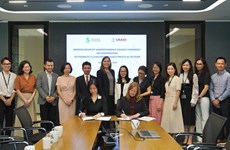Da Nang strives to become Vietnam’s major socio-economic centre
Prime Minister Nguyen Xuan Phuc has approved adjustments to the master plan on socio-economic development in Da Nang until 2020 with a vision to 2030, under which the central city will become one of the major socio-economic hubs in Vietnam and Southeast Asia.
 A corner of Da Nang city. Da Nang is striving to become a major socio-economic centre of Vietnam (Source: Internet)
A corner of Da Nang city. Da Nang is striving to become a major socio-economic centre of Vietnam (Source: Internet)Da Nang (VNA) – Prime Minister Nguyen Xuan Phuc has approved adjustments to the master plan on socio-economic development in Da Nang until 2020 with a vision to 2030, under which the central city will become one of the major socio-economic hubs in Vietnam and Southeast Asia.
Under this plan, Da Nang will develop towards an ecological, modern and smart city with its own identity. It will obtain fast and sustainable economic growth; promote people’s living standards to a high level; and focus on developing the three main pillars of tourism; hi-tech industry and sea-based economic activities; and ensuring defence, security, maritime security, and social order and safety.
In addition, the city has set a target of becoming a centre for start-ups, innovation, tourism, trade, finance, logistics, and information technology; and one of the major centres for culture, sports, education and training and health in the country.
The plan targets the city’s annual economic growth rate of 8 – 9 percent between 2016 and 2020, services making up 64 – 65 percent of the local economy while industry – construction 33 – 34 percent and agriculture 1 – 2 percent. The local population is set to reach some 1.6 million in 2020. Meanwhile, the employment rate is expected to rise by 4 – 5 percent each year during the 2016 – 2020 period, with trained labourers accounting for more than 50 percent of the total this year.
For 2021 – 2030, it looks to achieve average annual economic growth of 12 percent, with the services sector accounting for 67 – 68 percent of the economic structure, industry and construction 31 – 32 percent, and agriculture 1 percent.
The city’s population is projected to hit 2.5 million, while employment rate is estimated to increase by 5 – 5.5 percent a year with the proportion of skilled workers exceeding 70 percent by 2030. By 2030, 100 percent of solid waste, and 80 percent of waste water will be treated, and 100 percent of residents in rural areas will have access to clean water. Forest coverage is expected to reach 45 percent.
The master plan puts forward orientations for the development of services, industry and construction, and agriculture.
In terms of services, Da Nang will develop tourism services in line with resort properties with a focus on the Son Tra tourist site, Da Nang Bay, and entertainment projects; and develop seaports and airports in parallel with logistics services.
The city will maintain the harmonious development of trade, finance and banking activities, and increase the quality of services and products to serve tourism.
In terms of trade, the city will strive for a growth of over 8 percent in 2020 and 8.4 – 11 percent in the 2021 – 2030 period. The sector is expected to account for 12.9 percent of the city’s gross regional domestic product (GRDP) in 2020, and 15.4 percent by 2030.
Da Nang will focus on industrial development planning to avoid conflicts between industrial and tourism development targets, while developing environmentally-friendly industrial projects and eco-industrial zones.
It will put forward incentives to attract more investors, especially those in the world’s Top 500, and step up the application of information technology in production and business.
In the agricultural sector, Da Nang will form hi-tech agricultural zones, manage and protect forest areas, and develop offshore fishing comprehensively and sustainably. It will speed up the completion of its fisheries logistics services and infrastructure and fulfil the target of turning it into an aquaculture centre in the central key economic region.
During 2021 – 2030, the sector’s growth is expected to reach 2.2 percent, accounting for 1 percent of the city’s GRDP by 2030./.













